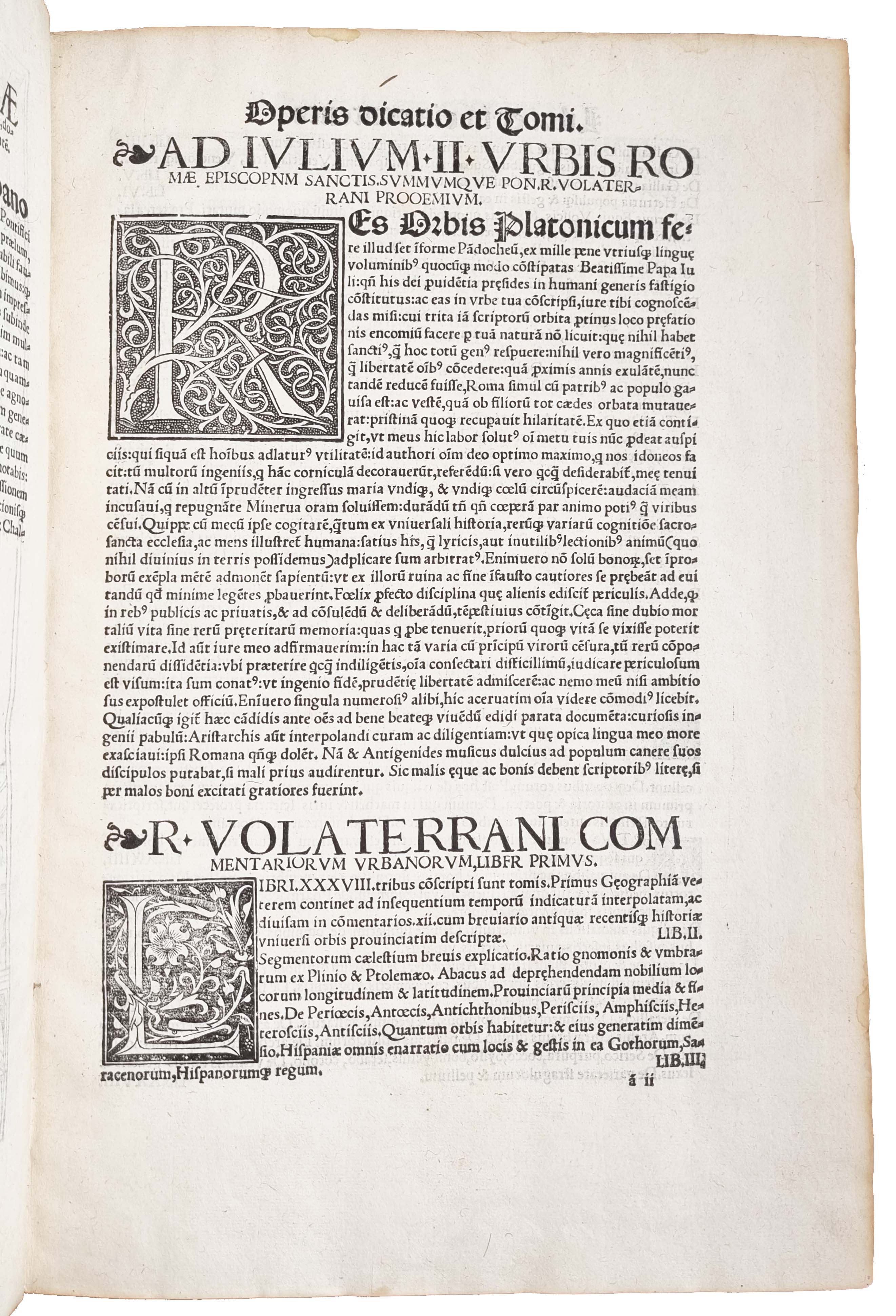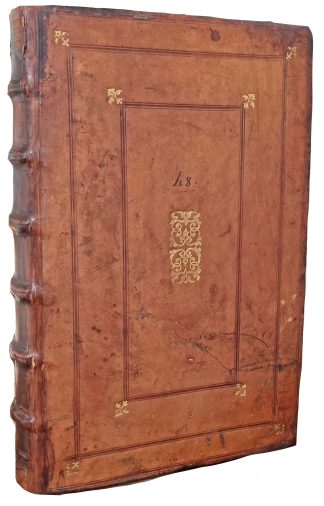MAFFEI, Raffaello.
RENAISSANCE ENCYCLOPEDIA - AMERICANUM
Commentariorum urbanorum […] octo et triginta libri. […] Item Oeconomicus Xenophontis.
Paris, C. Resch, [1526].£2,750.00
Folio. ff. [18], 422. Roman letter. Title in red and black within charming woodcut border of grotesques, putti, a scholar at his desk and warriors on horseback, large printer’s woodcut device, decorated initials and ornaments. Slight water stain to upper blank edge or margin of first and last gathering. An excellent, clean copy in contemporary French calf, double blind ruled, gilt fleurons to corners, gilt arabesque centrepieces, raised bands, horizontal hatching at head and foot of spine, corners, joints and head and foot of spine repaired, few light water stains or scratches to covers, ms ‘48’ inked to upper cover. C18 ms ‘Jacobus Edmund[us] Grosjean Falconiensis p[re]sbyter canonicus th. Bisunt’ (Jacques-Edmond Grosjean de Faucogney, Haute-Saône), twice to title, the odd contemporary ms marginal note.
An excellent, attractively bound copy of this handsomely produced edition of one of the earliest Renaissance encyclopaedias, with a mention of Columbus’s discoveries. Raffaello Maffei (1451-1522), from Volterra, was a theologian and humanist; he was acquainted with Pico della Mirandola, Poliziano and Lorenzo de’ Medici, and studied Greek under George of Trebizond. First published in 1506, ‘Commentaria’ is his ‘magnum opus’ – an encyclopaedia encompassing the entire knowledge of his time, from theology to biology. Part I, on geography, begins with a few sections on the heavenly spheres, the use of the gnomon to calculate latitude, with data on specific places worldwide, and the inhabited world at different latitudes. The remainder is a historical and geographical survey, based on ancient, medieval and contemporary sources, of the main regions and states in the world, from Spain, France, Poland and ‘Britannia’ (with an account of the ancient kings of Britain from Brutus to Uther Pendragon, and mention of Merlin, the Saxon kings, the Conquest, the Angevins, Thomas à Beckett and the War of the Roses, down to Henry VII), the Middle East, India, northern Africa, and places recently discovered (‘loca nuper inventa’) under the patronage of the King of Spain. This last section includes a mention of Columbus’s discovery in 1496 [sic]. Part II, on anthropology, is a gallery of ‘vires illustri’, in alphabetical order, from the rulers, poets and philosophers of the ancient world, to the Fathers of the Church, medieval theologians (e.g., William of Ockham), heresies (e.g., Albigenses), popes, religious orders, and dozens of major humanists of his time, e.g., Aretinus, Chrysoloras, Filelfo, Bessarion, Gaza, Ficinus and Picus, as well as painters (e.g., Mantegna, Leonardo, Donatello, Bellini). Part III, on Philology, begins with sections on body parts, including medical conditions (e.g., ulcers, abscesses, fevers), proceeding to kinds of mammals, fish and insects, local, exotic and mythical; colour pigments, gemstones, metals; architecture and related machinery; leather; character traits; laws; language (orthography, diction, accents); and astronomy. The last few pp. Include Maffei’s translation of Xenophon’s ‘Oeconomicus’, the most famous and ancient manual of husbandry and household management.
This is one of four issues published in 1526, all by Ascensius.
USTC 187310; Moreau III 1046; Pettegree & Walsby 78574; Sabin 43765. No other copies recorded in US.In stock





